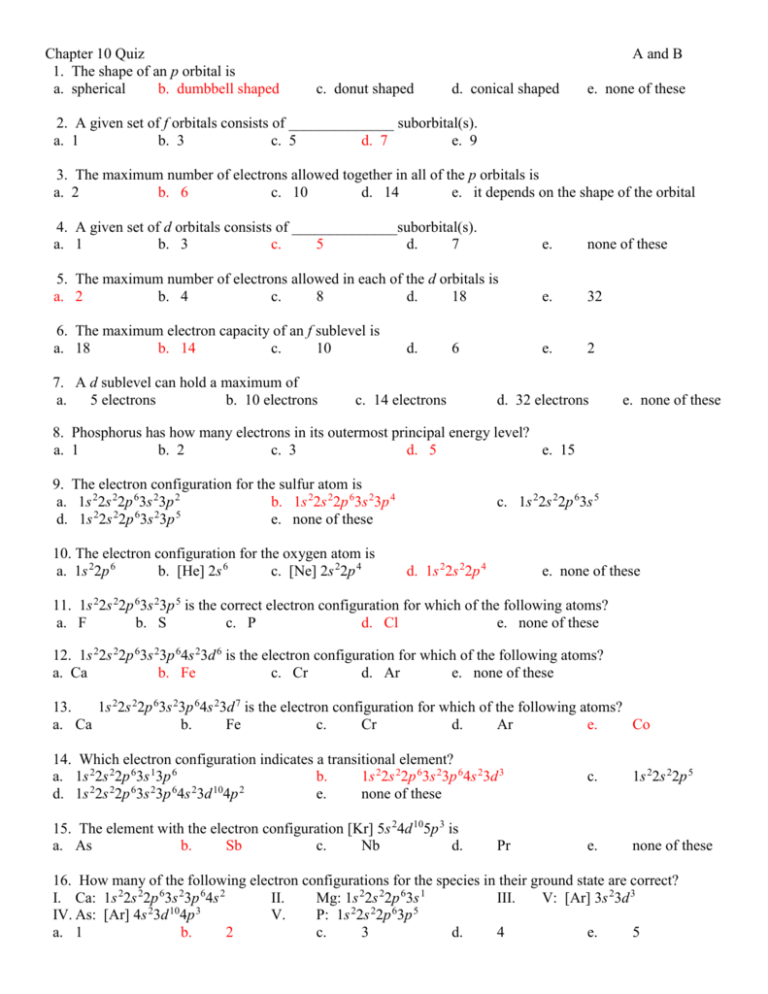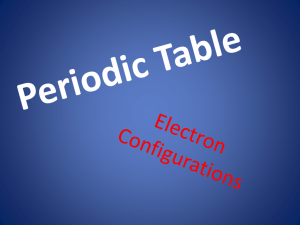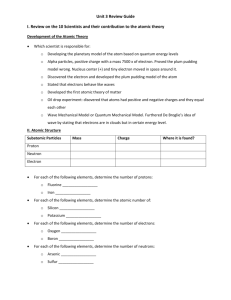Chapter 10 Quiz A and B 1. The shape of an p orbital is a. spherical
advertisement

Chapter 10 Quiz 1. The shape of an p orbital is a. spherical b. dumbbell shaped A and B c. donut shaped d. conical shaped e. none of these 2. A given set of f orbitals consists of ______________ suborbital(s). a. 1 b. 3 c. 5 d. 7 e. 9 3. The maximum number of electrons allowed together in all of the p orbitals is a. 2 b. 6 c. 10 d. 14 e. it depends on the shape of the orbital 4. A given set of d orbitals consists of ______________suborbital(s). a. 1 b. 3 c. 5 d. 7 e. none of these 5. The maximum number of electrons allowed in each of the d orbitals is a. 2 b. 4 c. 8 d. 18 e. 32 6. The maximum electron capacity of an f sublevel is a. 18 b. 14 c. 10 e. 2 7. A d sublevel can hold a maximum of a. 5 electrons b. 10 electrons d. 6 c. 14 electrons d. 32 electrons e. none of these 8. Phosphorus has how many electrons in its outermost principal energy level? a. 1 b. 2 c. 3 d. 5 e. 15 9. The electron configuration for the sulfur atom is a. 1s 22s 22p 63s 23p 2 b. 1s 22s 22p 63s 23p 4 d. 1s 22s 22p 63s 23p 5 e. none of these 10. The electron configuration for the oxygen atom is a. 1s 22p 6 b. [He] 2s 6 c. [Ne] 2s 22p 4 c. 1s 22s 22p 63s 5 d. 1s 22s 22p 4 e. none of these 11. 1s 22s 22p 63s 23p 5 is the correct electron configuration for which of the following atoms? a. F b. S c. P d. Cl e. none of these 12. 1s 22s 22p 63s 23p 64s 23d 6 is the electron configuration for which of the following atoms? a. Ca b. Fe c. Cr d. Ar e. none of these 13. 1s 22s 22p 63s 23p 64s 23d 7 is the electron configuration for which of the following atoms? a. Ca b. Fe c. Cr d. Ar e. Co 14. Which electron configuration indicates a transitional element? a. 1s 22s 22p 63s 13p 6 b. 1s 22s 22p 63s 23p 64s 23d 3 d. 1s 22s 22p 63s 23p 64s 23d 104p 2 e. none of these 15. The element with the electron configuration [Kr] 5s 24d 105p 3 is a. As b. Sb c. Nb d. Pr c. 1s 22s 22p 5 e. none of these 16. How many of the following electron configurations for the species in their ground state are correct? I. Ca: 1s 22s 22p 63s 23p 64s 2 II. Mg: 1s 22s 22p 63s 1 III. V: [Ar] 3s 23d 3 IV. As: [Ar] 4s 23d 104p 3 V. P: 1s 22s 22p 63p 5 a. 1 b. 2 c. 3 d. 4 e. 5 17. What element has the electron configuration 1s 22s 22p 63s 23p 64s 13d 10? a.Zn b. Ga c. Cu d. Cd e. Ag 18. What element has the electron configuration 1s 22s 22p 63s 23p 64s 23d 104p 65s 24d 105p 66s 24f 145d 106p 2? a.Ba b. Sn c. Pb d. Po e. none of these 19. Relatively speaking, the 1s orbital is ________then the 3s orbital a. smaller b. larger c. about the same size 20. Which is the least metallic? a. lithium b. silicon c sulfur d. chorine 21. most metallic? a. Na b. 22. smallest ionization energy a. N 23. smallest atomic radius Si d. need more information c. S d. Hydrogen b. P c. As d. Sb a. Ca b. Ba c. Sr d. Mg 24. greatest electron affinity a. Si b. Al c. S d. P 25. largest atomic radius a. P b. Al c. Si d. S 26. highest ionization energy a. B b. C c. N d. O a = Ge, b= P, c =O 27. Which of the three has the largest atomic radius? a 28. Which of the three has the smallest atomic radius? c a = Ba, b = Cu, c = Ne 29. Which of the three has the highest ionization energy? c 30. Which of the three has the lowest ionization energy? a a = K, b = Mg, c = P 31. Which of the three has the highest electron affinity? c 32. Which of the three has the lowest electron affinity? a







